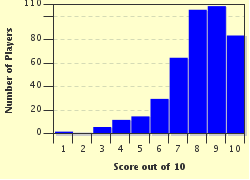Quiz Answer Key and Fun Facts
1. Rome 69 AD: After a year of civil war that had erupted when Nero was deposed, the senate declares Vespasian the new emperor. Finally a strong leader has taken power again. Order has to be restored and Rome has to be rebuilt. One of the buildings ordered by Vespasian will be the largest of its kind in the Roman Empire, one of the great works of Roman architecture and today recognised as one of the new seven wonders of the world. Which building is this?
2. The Baths of Caracalla, the Circus Maximus, the Colosseum and the Pantheon are all famous landmarks of Rome. But this city has more to offer. It is the only capital in the world that has a whole country within its boundaries. I'm of course referring to Vatican City. In Vatican City we find a central square located in front of a basilica. Both are named after which famous saint?
3. Saint James, Saint John, Saint Paul and Saint Peter are all famous saints who have several cathedrals named after them. However, there's also a very famous Saint Basil's cathedral. This cathedral with its colourful onion domes is an iconic landmark of which European capital?
4. Athens, Dublin, Moscow and Paris are all European capitals, but they are also cities in a state of the USA. Which state is this?
5. Arizona, California, New Mexico and Texas are the four American states that border Mexico. Mexico's capital, Mexico City, is founded on the ruins of Tenochtitlan. In the beginning of the 16th century this was one of the biggest cities in the world and the capital of which pre-Columbian culture?
6. Aztecs, Olmecs, Toltecs and Zapotecs are all examples of Native American cultures. It is generally accepted that the first inhabitants of America originate from Asia and emigrated to America via a land bridge that connected Siberia with Alaska during the last ice age. When the ice melted the continents became separated. What is the name of the strait between Siberia and Alaska?
7. The Bass Strait, Bering Strait, Cook Strait and Strait of Magellan haven't always existed. At several times in our earth's history all the land mass was concentrated on one single continent. The last time this happened was approximately 300 million years ago. How is this single large supercontinent called?
8. Eurasia, Gondwana, Laurasia and Pangaea date from different phases in the geological history of our planet. If we go even further back in time we see that the solar system, of which our planet is part, formed approximately 4.6 billion years ago. There are eight planets in our solar system. Which of the four listed below is NOT named after a Roman god?
9. Jupiter, Neptune and Uranus are all gas giants, whilst Mars has a rocky surface. On Mars you can find the highest mountain in our solar system. What is the name of this gigantic mountain?
10. Ascraeus Mons, Elysium Mons, Olympus Mons and Pavonis Mons are all volcanic mountains on Mars, but our earth also has its share of volcanoes. One of the most notorious volcanic eruptions was the one of Mount Vesuvius in 79 CE that buried the cities of Pompeii and Herculaneum. Who was the emperor of Rome when this disaster occurred?
Source: Author
AlonsoKing
This quiz was reviewed by FunTrivia editor
Snowman before going online.
Any errors found in FunTrivia content are routinely corrected through our feedback system.


